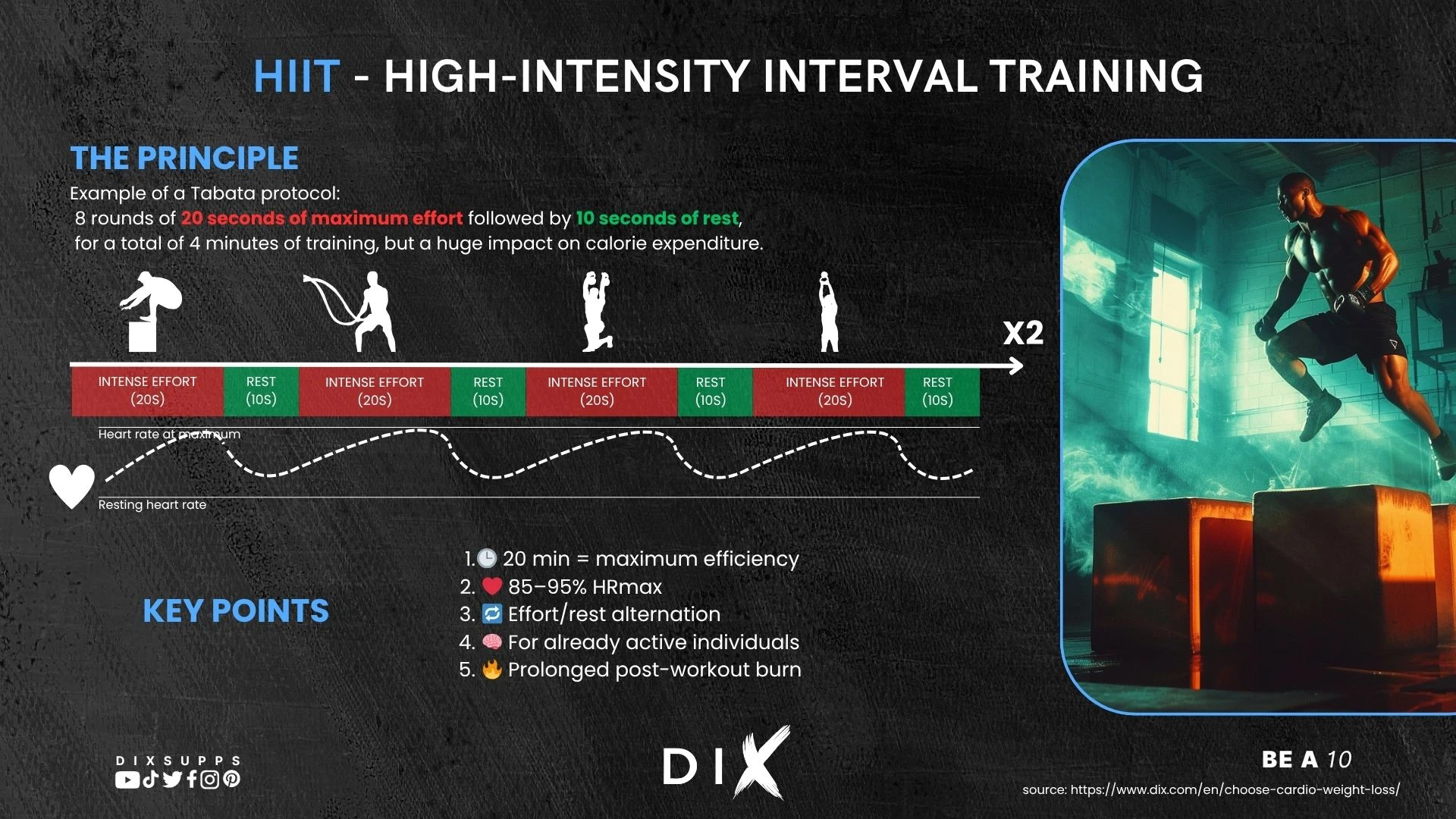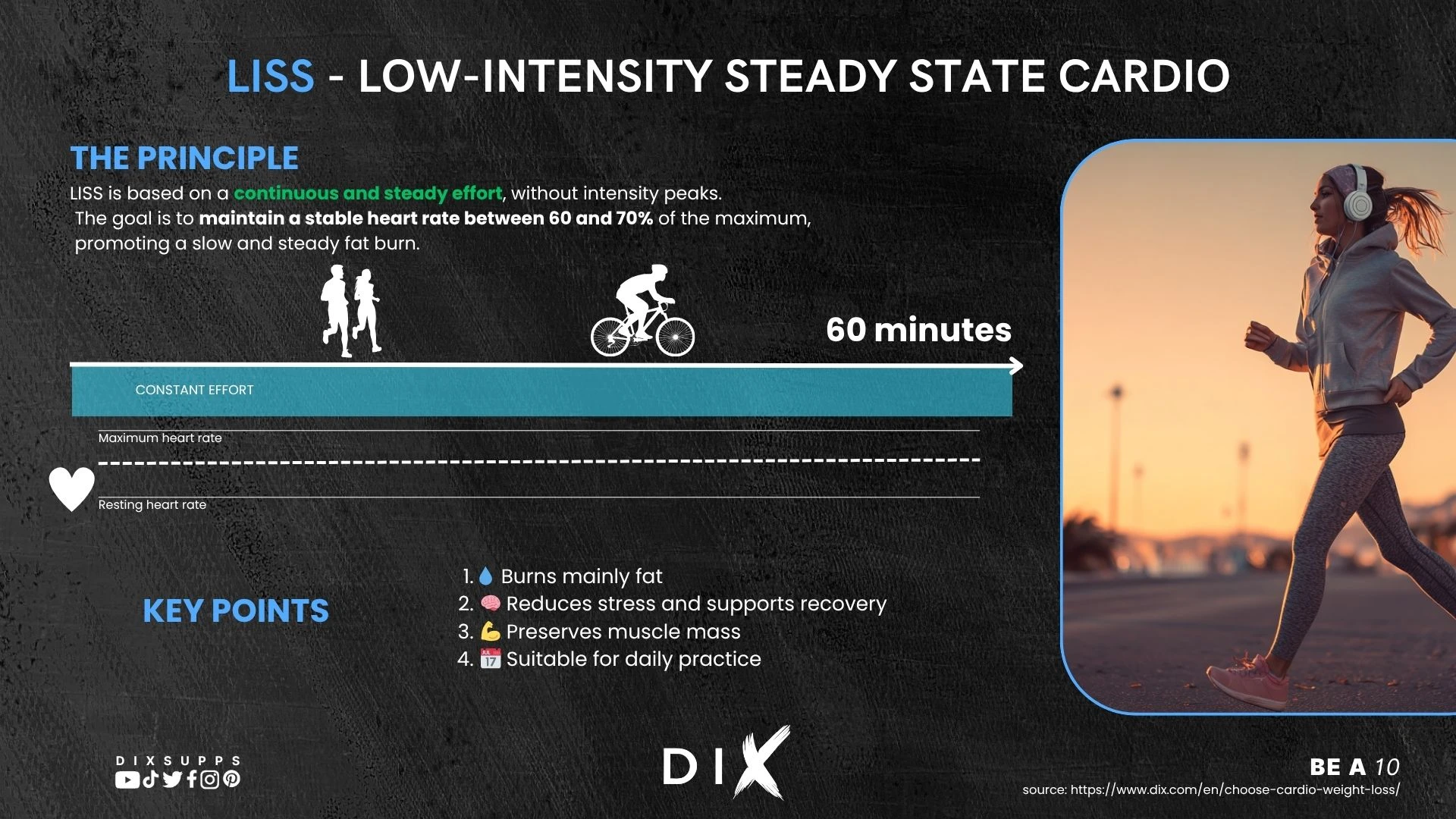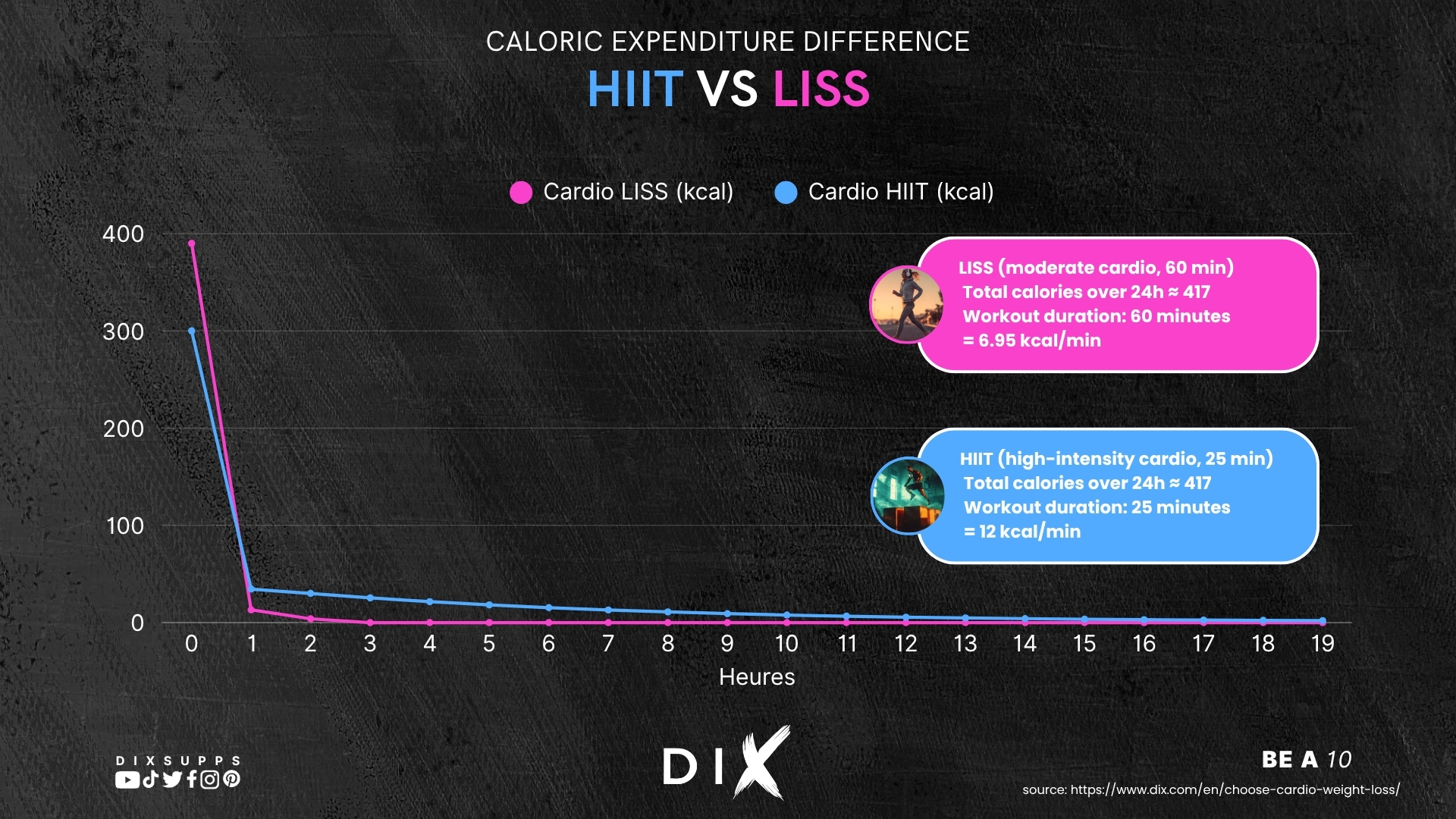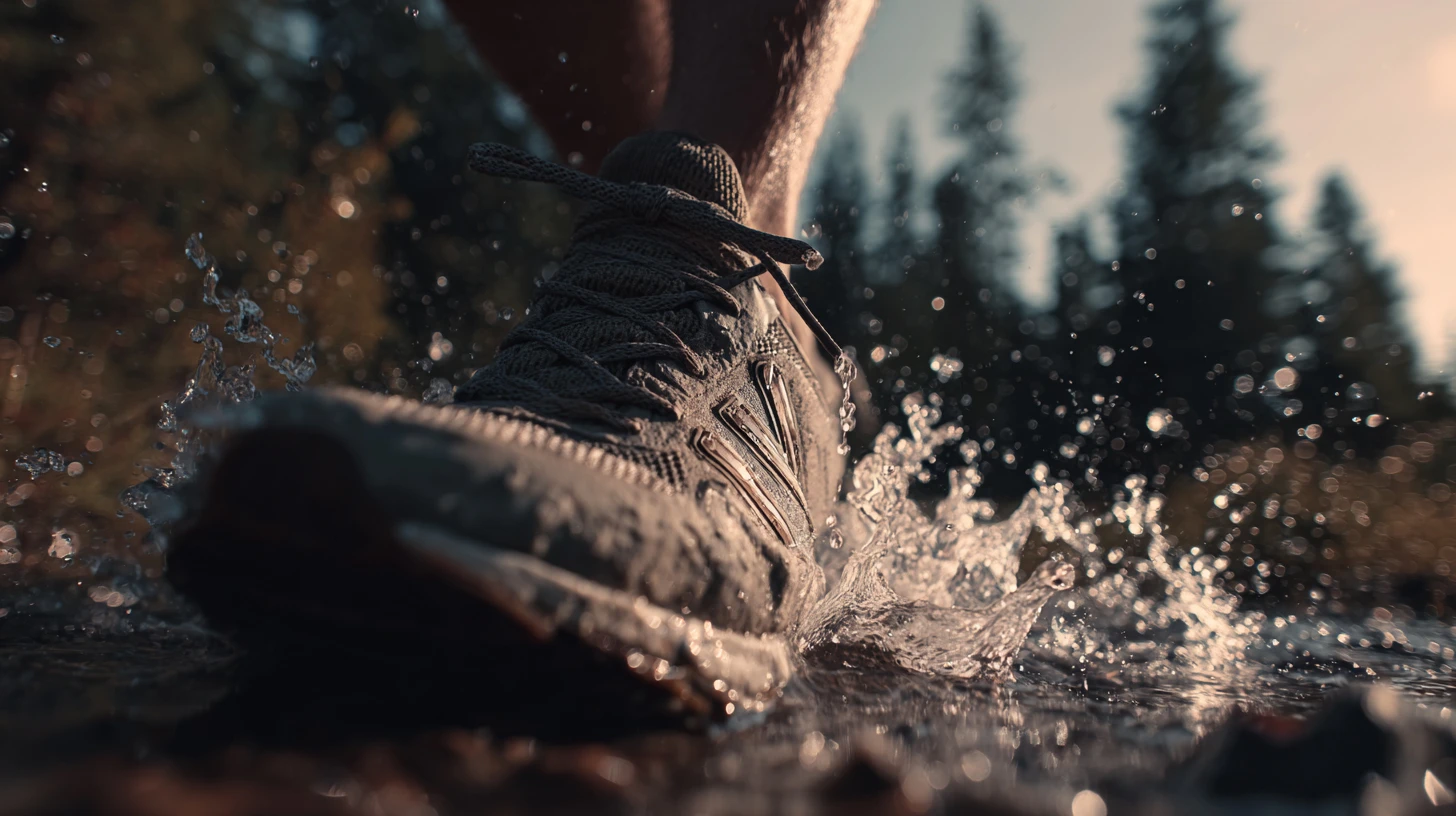Cardio for Weight Loss: Choose According to Your Goals
We’ve always known it: as soon as it comes to lose weight, we talk about CARDIO. And it's true, cardio will help you "lose weight." But be careful, the CARDIO, it’s not just about running for miles in the hope of melting away fat (and often, that’s where the mistake begins).
Because a poorly suited cardio, instead of boosting your metabolism, it can actually slow you down. Yes, you read that right: if not dosed correctly, it can completely hinder your progress and have the opposite effect of what you're aiming for.
Cardio Questionnaire!
Before diving into the theory, here's a quick questionnaire to help you find the ideal cardio routine for you, based on your profile, activity level, and available time.
Your cardio recommendation
Complete the questionnaire to uncover your profile.
- A calorie deficit remains the key driver of weight loss. Cardio workouts boost your energy expenditure, but without a calorie deficit, fat loss remains limited. A moderate deficit (200 to 500 kcal per day) allows for sustainable progress without exhaustion.
- HIIT burns more in less time Thanks to the EPOC effect, the body continues to burn calories for several hours after exercise. This is perfect for experienced athletes looking for quick weight loss, provided they avoid overtraining.
- The LISS promotes consistency and recovery. At a moderate intensity, it targets fat as an energy source while preserving muscle mass. Ideal for beginners or as a complement to weight training sessions.
- Strength training and cardio complement each other. Strength training boosts your resting energy expenditure, while cardio enhances fat burning. Together, they help you shed fat while sculpting your physique.
- An unbalanced workout can hinder your metabolism. Too much intense cardio or an excessive deficit can raise cortisol levels and hinder progress. The key lies in finding the right balance between intensity, recovery, and nutrition.
- Sleep and stress management have a direct impact on your results. Lack of rest disrupts leptin and ghrelin levels, leading to increased hunger and water retention. Getting enough sleep and reducing stress support sustainable fat loss.
The two main types of cardio: high vs. low intensity
We have various options for CARDIO that will primarily depend on you, your pace, and the type of effort you enjoy putting in, much more than the outcome it will bring. (Because when you enjoy an effort, you keep doing it. And that’s precisely the real secret to progress.)
The best cardio choice for weight loss depends on your goals and, above all, your ability to persevere. Let’s break down the two main approaches together.
High-Intensity Interval Training (HIIT)
Le HIIT High-Intensity Interval Training intense bursts of effort (85 to 95% of your maximum heart rate) and very short recovery phases. For example, the protocol Tabata perform 20 seconds of maximum effort followed by 10 seconds of rest, repeated 8 times. This is the kind of format that is commonly found in CrossFit, a training method that heavily relies on interval work and varying intensity. These short yet explosive sessions can include burpees, cycling sprints, or even step-ups.
The main advantage of HIIT, it's the effect EPOC (post-exercise oxygen consumption excess). Even after your workout, your metabolism remains active for several hours, continuing to burn calories. You can compare this to a compound interest You put in intense effort, and your body continues to "cash in" on that expenditure by burning calories even after the session. (In other words, you keep reaping the benefits even after you've stopped sweating.)
A well-structured 20-minute workout can thus outperform a session of classic cardio in terms of total calorie expenditure. But be careful: this type of effort requires a solid fitness foundation and a genuine sense of consistency. The "miracle" protocols of 10 minutes that you see online often don't exceed 70% of maximum heart rate. limiting the actual fat-burning effects.

Low-Intensity Steady State Cardio (LISS)
The LISS (Low-Intensity Steady State) maintains a moderate effort (60-70% of maximum heart rate) for 30 to 60 minutes. Incline walking, breaststroke swimming, or cycling at a steady pace are some concrete examples.
Its strength lies in its ease of integration into your routine. You can listen to a podcast while walking, watch a video while cycling at a leisurely pace, or follow up a workout session with another for active recovery. Unlike HIIT, it doesn’t drain your nervous system, allowing for a regular practice without the risk of overtraining.
By primarily burning fat rather than carbohydrates, the LISS helps maintain your muscle massA study shows that it more effectively improves fat distribution in overweight individuals. However, it takes about two to three times longer to achieve a calorie burn equivalent to a HIIT session.
- Better suited to muscle preservation goals
- Perfect for active recovery
- Accessible to all levels fitness
- May be associated with other daily activities

Which cardio should you choose based on your main goal?
Alright, now that we know the two main forms of CARDIO, you must be wondering: which one is most effective for you ?
Let's take a look at two typical profiles to gain a better understanding.
Objective No. 1: lose weight as quickly as possible
You want lose weight quickly ? The high-intensity cardio (HIIT) is clearly your ally. By alternating between phases of maximum effort and short recoveries, you can burn more calories in 20 minutes rather than an hour of brisk walking.
But this effectiveness has a downside: the HIIT intensely challenges your nervous system and taps into your glycogen reserves. Combining weight training and HIIT on the same day can affect your muscle gains... or not, it all depends on how you structure your workouts.
For example, in CrossFit, we actually focus on interval training, but with weights that can be quite heavy at times. The result is that we manage to build muscle while burning fat. Why? Because calorie intake is often high alongside, and the exercises involve a genuine muscle intensity. (It’s the delicate balance between training load, nutrition, and recovery that makes all the difference.)
On the other hand, for someone just starting out, this type of training will definitely require a lot of energy. HIIT is demanding You need to measure it out, respect it, and give it time to work without rushing the process. (It’s better to take it slow than to burn out in the first week.)
Objective No. 2: Lose fat while preserving muscle mass
You will have understood, if the HIIT allows you to lose weight very quickly. The LISS, it offers you a more gradual, slower weight loss, but often more stable over time. And above all, it allows you to better maintain your muscle mass. (Provided that, like with HIIT, you also do a bit of weight training on the side.)
Unlike the HIIT, the LISS don’t deplete your energy reserves. It helps you burn calories without tapping into your muscles, making it a perfect choice for sculpt your physique without sacrificing your gains.
This type of effort also promotes the active recovery between more intense sessions. It helps you maintain good circulation, better oxygenation, and therefore a steady progression. To track your progress and adjust your training, use our IMM calculator.
| Criterion | High-Intensity Interval Training (HIIT) | Low-Intensity Steady State Cardio (LISS) |
|---|---|---|
| Caloric expenditure / minute | Very high | Moderate to low |
| Impact on Muscle Mass | High risk of interference (catabolism) | Very low, perfect for preservation |
| Impact on Recovery (Nervous & Joint) | High | Low |
| Session duration required | Short (15-25 min) | Long (45-60+ min) |
| Sustainability / Long-term adherence | Challenging for many | Easy to incorporate |
| Perfect for | Rapid weight loss | Cutting, muscle preservation |
Between these two approaches, there is a compromise: combining 1 to 2 HIIT sessions with 2 to 3 LISS sessions. However, this strategy is reserved for experienced practitioners. Beginners should prioritise the SMOOTHa strong foundation for progressing without discouragement.
Remember the essential equation: a controlled calorie deficit remains keyYour best ally remains the cardio you do without frustration, week after week.


The mistake to avoid: neglecting strength training
Well, we've talked a lot about CARDIO For lose weight, but one of the biggest mistakes that many people make is to neglecting weight trainingIt's actually very simple to understand: the more you have of muscle mass, the more energy your body needs to function daily.
Every 500 g of muscle burns approximately 100 kcal per day, at restYes, you read that right: even when you're doing nothing, your body burns more calories if you're muscular. The result? You might not see a significant drop on the scales, but you feel more toned. lean, more toned, because your metabolism works for you around the clock.
The best way to maintain this muscle is simply to engage in bodybuilding. Only do CARDIO Mostly LISS LISS) will undoubtedly help you lose weight, but there is a risk of looking like what is commonly referred to as a skinny fat slim, but lacking tone and visible muscle definition.
Every time you lift heavy weights, you create micro-tears in your muscles. These tiny tears are completely normal: your body repairs them, and it’s this very process that helps your muscles grow and strengthen. This repair work also requires energy. (In other words, you’re still burning calories even after the workout.)
So yes to CARDIO, but not without bodybuilding. Conversely, strength training alone won't be enough either: the two complement each other perfectly if your goal is to burn fat while sculpting your body.
Caloric deficit: more crucial than cardio
Le CARDIO is just a lever. As its name suggests, in CARDIO there is cardiaque, so heart. The CARDIO is not primarily intended for weight loss, but to enhance your heart health, boost your endurance, and support your body in its daily efforts.
La weight loss depends on a single factor: burn more calories than you consumeYour body functions like a bank account: meals are deposits, while energy expenditure represents withdrawals. A deficit occurs when withdrawals exceed deposits, prompting the body to tap into its fat reserves. So, whether it’s about finances or your diet, you’ll need to carefully assess these expenditures and deposits.
And to help you calculate all of that without any hassle, we have created a basal metabolic rate calculator which will be your starting tool to ensure you don't begin haphazardly.
You’ve got it, a significant deficit (for example, 700 kcal less per day) can harm your body: fatigue, muscle loss, slowed metabolism… Instead, go for a moderate deficit (around 200 to 500 kcal per day), compatible with maintaining your muscle mass. For instance, you can burn around 300 calories a day through a combination of physical activity and a slight reduction in your diet. The CARDIO boosts expenditure, but without dietary control, its effects remain limited. A sustainable deficit is always better than a one-off extreme effort.
La perseverance consistency always outweighs intensity. A slight but regular deficit is more effective than a drastic diet. A daily 30-minute walk, combined with balanced meals, already creates a sustainable deficit. A professional can then help you adjust your intake according to your metabolism.
So there you have it, you’ve got to understand that cardio without a proper diet for weight loss won’t really help you… Hmm… not much at all.

The FAQ on "Why am I not losing weight despite cardio?
Here’s a quick reminder of the main reasons that might explain why you’re not losing (or no longer losing) weight despite your activity. CARDIO.
- Your calorie deficit is no longer guaranteed Your body has adapted to your efforts and is now expending less energy than before. Solution: reassess your intake using a reliable method. (like the Harris-Benedict equations) and introduce variations in intensity during your workouts. Advice: alternate the low-intensity cardio (brisk walking) and short but intense sessions (sprints).
- You're doing too much intense cardio. Too many demanding sessions increase the cortisol, the stress hormone, which promotes water retention and cravings. Solution: reduce the frequency a bit, and opt for gentler activities like swimming or using the elliptical, which limit the muscle catabolism. Tip: keep a maximum of 1 to 2 high-intensity sessions per week.
- Feeling stressed or lacking sleep? : these two factors disrupt the leptin (satiation) and the ghrelin (hunger), which hinders your results. Solution: aim for at least 7 to 8 hours of sleep each night and take active breaks. (walking, stretching) to lower your cortisol levels. Tip: steer clear of screens for an hour before bed.
- You're neglecting weight training. : without muscle stimulation, tone metabolism slow down. Solution: add 2 to 3 strength training sessions per week (with dumbbells or bodyweight). Tip: focus on compound exercises like squats or pull-ups to maximise the afterburn effect.
- You’re confusing weight with body composition. The scales can be misleading. You might be losing fat while gaining muscle. Solution: rely on more tangible indicators. (waist measurement, photos) and make sure to include some proteins with every meal.
Caloric deficit and rate of weight loss
- Impact of two different rates of weight loss on body composition and strength (Slow weight loss of around 0.7% per week better preserves lean mass compared to a rapid loss of 1.4% per week) DOI: DOI
Proteins and Muscle Preservation
- Consuming higher levels of dietary protein compared to lower amounts during an energy deficit, alongside intense exercise, leads to a more significant increase in lean muscle mass. High protein intake during a deficit promotes the preservation and even gain of lean muscle mass. DOI: DOI
- A systematic review, meta-analysis, and meta-regression of the impact of protein supplementation on gains from resistance training. (Beyond 1.6 g/kg/day, the benefits for hypertrophy plateau under normal conditions) DOI: DOI
Cardio, HIIT and Interference
- Concurrent training: a meta-analysis exploring the interference between aerobic and resistance exercises (Cardio can limit strength if done too often, especially running) DOI: DOI
- Effects of high-intensity interval training versus moderate-intensity continuous training on body fat (HIIT as effective as steady-state cardio, but more time-efficient) DOI: DOI



